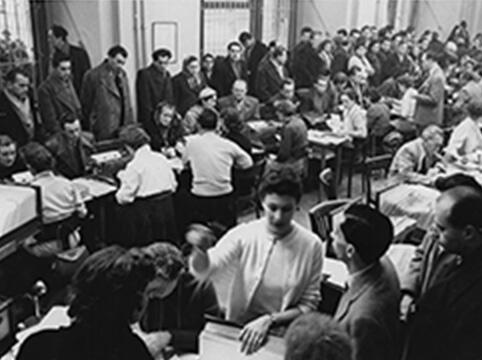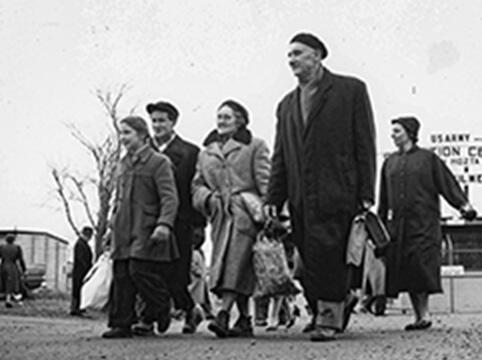Operation Safe Haven: The Hungarian Refugee Crisis of 1956
In November 1956, a failed revolt against Communism in Hungary spurred the greatest refugee crisis in Europe since the end of World War II. President Dwight D. Eisenhower and his administration, including the Immigration and Naturalization Service (INS), moved swiftly in response. Through the hard work of INS employees as well as the State Department, the military, and civilian volunteers, over 30,000 refugees resettled in the United States over an eight-month period. The success of “Operation Safe Haven”, set a precedent for the U.S. to respond to humanitarian crises through expanded presidential powers.
The crisis began on Oct. 23, 1956, when students in Budapest demonstrated against Soviet control. In the following days, fighting broke out between Hungarian revolutionaries and communist loyalists across the country. At first it looked as if the Soviet Union might allow for liberalization in Hungary, but on Nov. 4, a reported 1,000 Soviet tanks rolled into Budapest to put down the rebellion. Scholars estimate that close to 3,000 Hungarians and 700 Red Army soldiers died in the fighting that finally ended on Nov. 11 with a Soviet declaration of victory.
However, a humanitarian crisis was soon to follow. Five days after the fighting first broke out, a crying woman walked across the Hungarian border into Austria, where troops greeted her with food and drink. The Austrian government immediately recognized her as a refugee. Her photo ran on the front pages of newspapers across the United States. The exodus of Hungarians had begun. Over the following months approximately 200,000 people—or 2% of the population—left Hungary. Most crossed by foot into Austria.
Austria’s leaders initially welcomed the Hungarians, but the country was soon overwhelmed. They asked for help resettling the refugees and paying for their care; those costs eventually mounted to over $100 million in today’s currency. The United Nations echoed Austria’s pleas, and over 20 member states responded, including the U.S.

On Nov. 8, President Eisenhower declared that 5,000 Hungarians would be awarded visa numbers remaining under the 1953 Refugee Relief Act, and INS Commissioner Joseph M. Swing sent INS employees to Vienna to begin processing the refugees. Commissioner Swing traveled to Hungary, where he witnessed a Red Army soldier shoot an escaping Hungarian near the Austrian border.
Press coverage of this and similar incidents led to great public sympathy for the Hungarian people, and President Eisenhower used the parole authority provided by the Immigration and Naturalization Act of 1952 (INA) to allow approximately 30,000 additional Hungarians to enter the country. This expansive use of presidential parole power under the INA set a precedent followed by succeeding administrations to the present day, including the recent Afghan evacuation.
The U.S. military launched “Operation Safe Haven” and transported refugees out of Austria by plane and ship; most arrived in New Jersey for immigration processing at Camp Kilmer. Army Quartermaster troops prepared the camp to house, feed, and even entertain the migrants with TV and amateur theatricals. The camp had special facilities set up for required public health inspections and immigration interviews, as well as photographing and fingerprinting. Cooks prepared meals heavy in calories—up to 4,300 calories per day for each refugee—designed to counteract food deprivation, and they stockpiled infant formula for the youngest escapees.
The Newark, New Jersey, district immigration office initially reassigned workers to Camp Kilmer to handle the influx, assigning workers to a rotating schedule of 24-hour duties including inspections, investigations, legal oversight, records creation, and what managers called “myriad incidentals.” As the operation continued, and thousands of refugees entered the country each day, more East Coast INS employees relocated temporarily to New Jersey to help.

INS cooperated with external agencies and nonprofits to guide the refugees into American life. Once they passed their inspections, eligible adults received an I-25 identification card from INS and a social security card, and Department of Labor employees attempted to match their skills with jobs. Nonprofit sponsors guided them out of the camp and into civilian life. These nonprofits included the National Catholic Welfare Conference, Church World Service, United Hebrew Immigrant Aid Society, and the International Rescue Committee, among others.
U.S. Representative Charles J. Kersten (R-WI) praised the efforts of INS employees. They had “a very important role in carrying out the President’s purpose of cutting all red tape and yet carrying out the basic regulations.” While some politicians opposed the operation, fearing that the Hungarians would spread communist ideas, INS investigators found very few refugees who had lied to enter the country or showed evidence of radical sympathies. In 1958, Congress passed a law that allowed Hungarian parolees to become legal permanent residents.
INS Commissioner Joseph M. Swing recalled that the Hungarian refugee crisis challenged “every operation of the service.” Yet by the end of 1957, he could declare a victory for the INS. Employees kept pace with the rapid entry of Hungarians and balanced the need for efficiency with security. As a result, a program that began as an improvised response to a Cold War emergency established a precedent the U.S. could follow in future efforts to evacuate and resettle refugees and parolees in the United States.
For more information on the federal government’s response to past refugee crises, visit our Refugee Timeline on USCIS.gov. Did you like this story? Give us some feedback at cishistory.library@uscis.dhs.gov.
